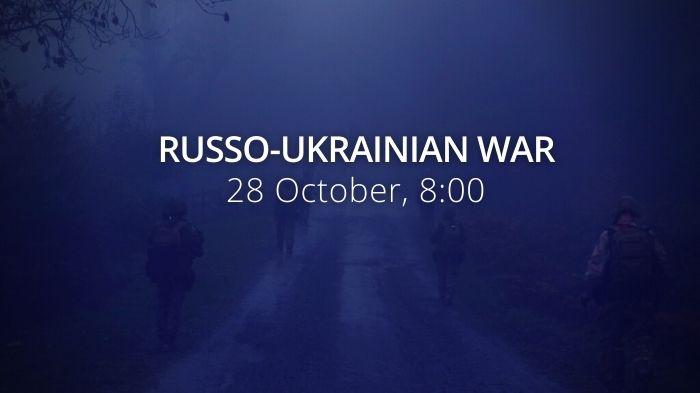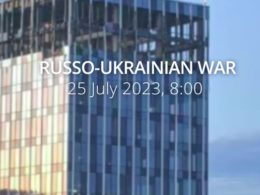Russian forces continued offensive operations in the directions of Bakhmut and Avdiivka and establishing fortifications in eastern Kherson Oblast. Ukraine will sign declarations on joining NATO with several states of the Alliance by the end of the year.
Daily overview — Summary report, November 26
A map of the approximate situation on the ground in Ukraine as of 00:00 UTC 27/11/22.
There have been no notable changes to control since the last update. pic.twitter.com/V7GTQ5F06D
— War Mapper (@War_Mapper) November 27, 2022
The General Staff’s operational update regarding the Russian invasion as of 06.00 am, November 26, 2022 is in the dropdown menu below:
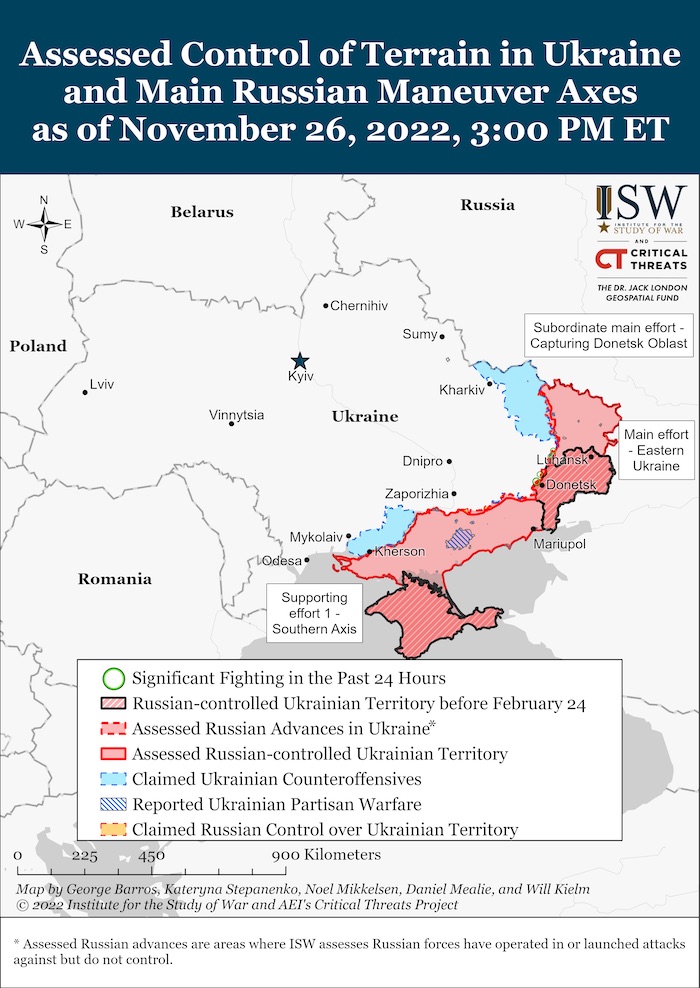
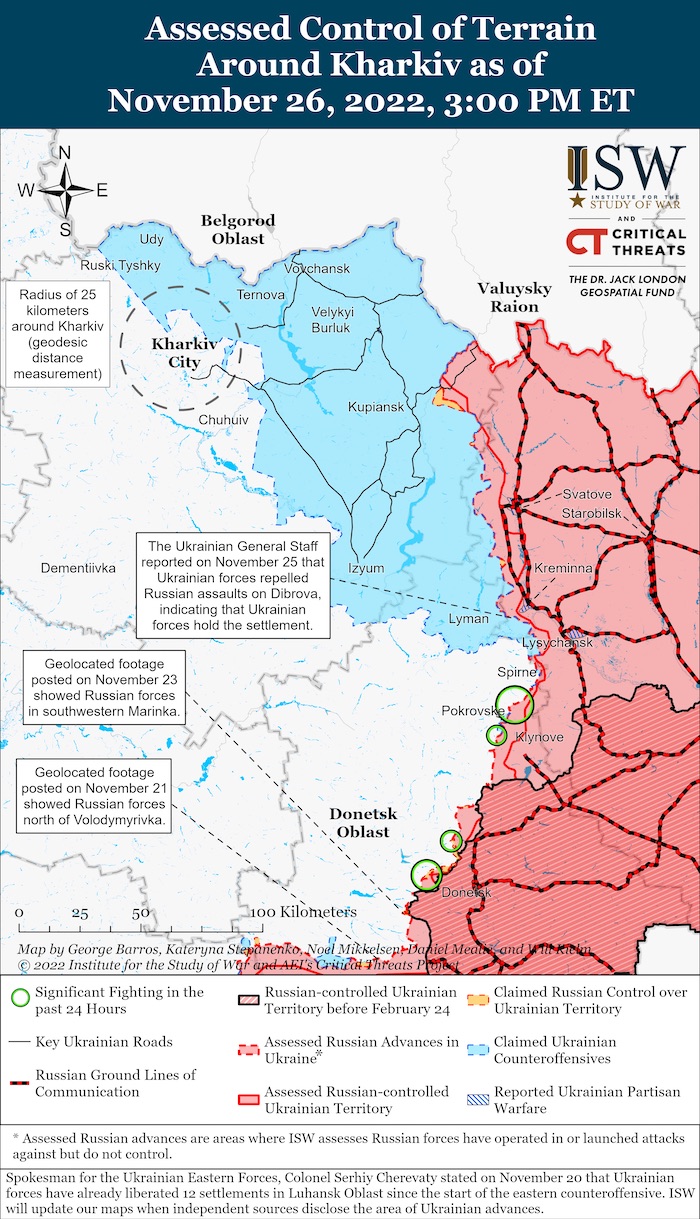
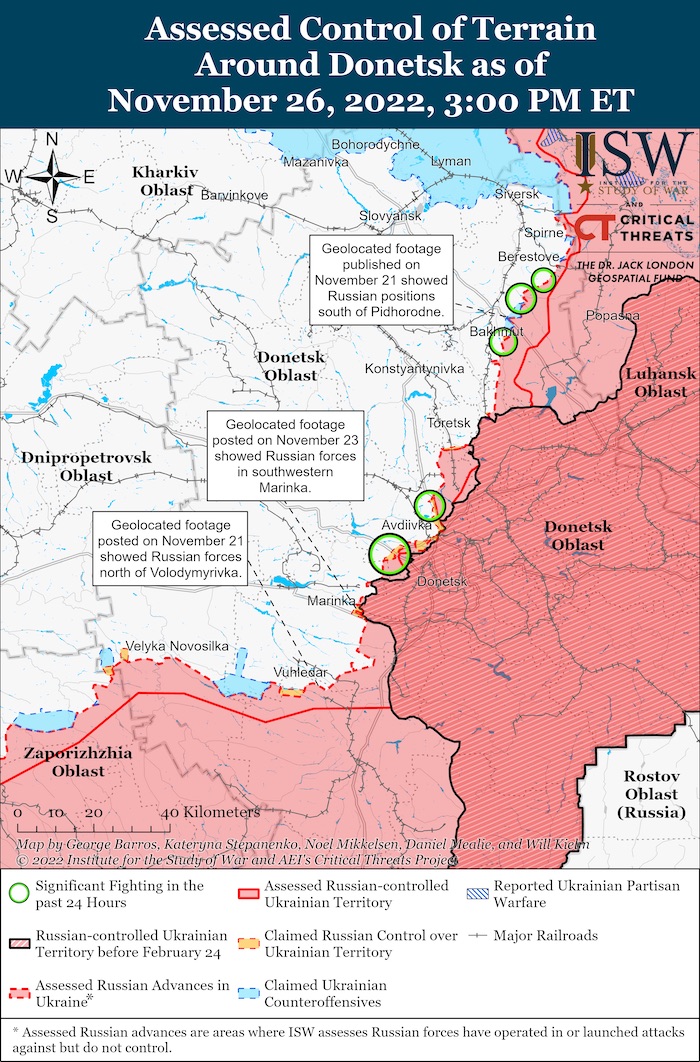
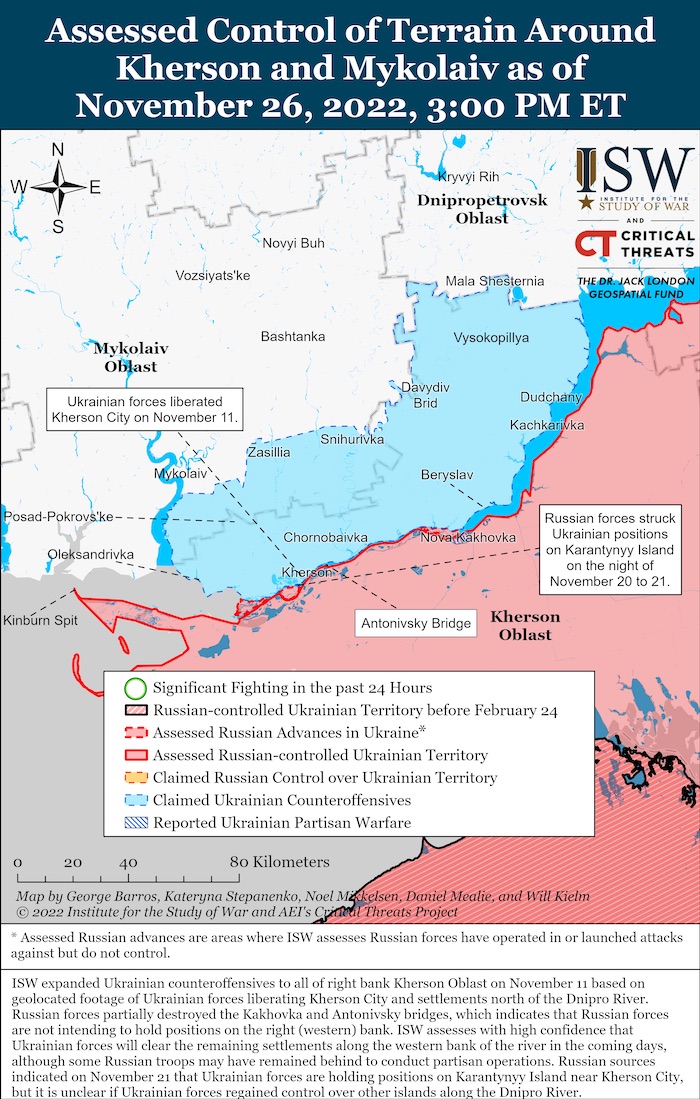
Military Updates
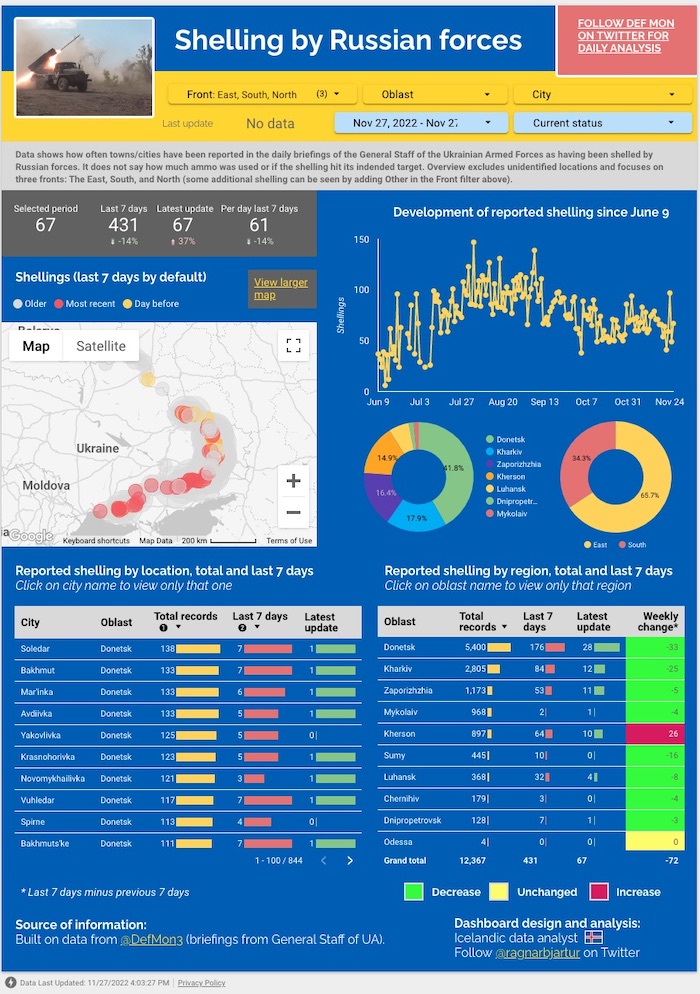
️“A day in Ukraine is like a month or more in Afghanistan,” said Camille Grand, defense expert at the European Council on Foreign Relations and former NATO Assistant Secretary General for Defense Investment. Ukraine fires thousands of artillery shells a day in its war with Russia. NATO forces in Afghanistan fired 300 rounds a day.
https://twitter.com/EuromaidanPress/status/1596594388930596868
According to British Defence Intelligence, (last 48 hours):
- The area around the towns of Pavlivka and Vuhledar in south-central Donetsk Oblast has been the scene of intense combat over the last two weeks, though little territory has changed hands.
- Both Russia and Ukraine have significant forces committed to this sector, with Russian Naval Infantry having suffered heavy casualties.
- This area remains heavily contested, likely partially because Russia assesses the area has potential as a launch point for a future major advance north to capture the remainder of Ukrainian-held Donetsk Oblast. However, Russia is unlikely to be able to concentrate sufficient quality forces to achieve an operational breakthrough.
Losses of the Russian army
As of 26 November, the approximate losses of weapons and military equipment of the Russian Armed Forces from the beginning of the war to the present day:
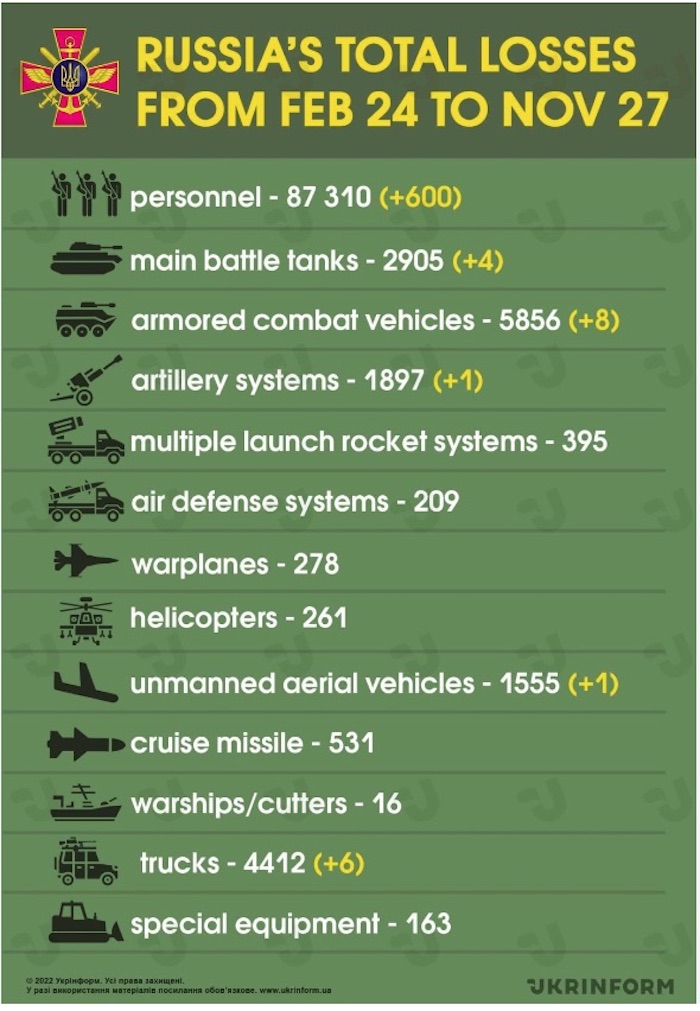
https://twitter.com/EuromaidanPress/status/1596262703655317505
Humanitarian
https://twitter.com/EuromaidanPress/status/1596627356197818370
Environment
️Legal
Lecturer beaten, ‘tried’ and imprisoned in Russian-occupied Crimea for a Ukrainian patriotic song. Read more here.
Support
Polish, Lithuanian & Ukrainian Prime Ministers held a Lublin Triangle meeting in Kyiv, signed a cooperation
The Lublin Triangle of Ukraine, Poland & Lithuania was created in 2020 for closer cooperation, reflecting also shared history of 14-18 cent. https://t.co/t5DN2cbVas pic.twitter.com/2qUx2K35Yr
— Euromaidan Press (@EuromaidanPress) November 26, 2022
New Developments
Belgium signed declaration supporting Ukraine's EU and NATO membership
PM of Belgium, Alexander De Croo, said it is a great honor for him to be in Ukraine and to show his support to Ukraine and its people https://t.co/Mqby53EOtJ pic.twitter.com/9v5LoBA2wp
— Euromaidan Press (@EuromaidanPress) November 26, 2022
- Belgium - 10 million euros;
- France - 6 million euros (in addition to 14 million previously allocated to the UN World Food Programme);
- Austria - an additional 3.8 million euros for the delivery of grain from Ukraine to Sudan and Ethiopia;
- Hungary - allocates $3.5 million for the transportation of food from Ukraine, and will also provide logistical support;
- Poland allocates 20 million euros;
- The Netherlands will allocate 4 million euros;
- Canada donates 30 million Canadian dollars;
- Germany will contribute 15 million euros
- Qatar will allocate $20 million
Canadian journalist Rhea Clyman was first to write about 1932 genocidal famine Holodomor, which killed 3.9 million ppl in Ukraine. Her punishment for revealing Stalin’s atrocities to the West was to be expelled from USSR, labeled “Bourgeois Troublemaker.” https://t.co/VgGRDq8B4T pic.twitter.com/qFG9hnu7dB
— Euromaidan Press (@EuromaidanPress) November 26, 2022
5,000 peasant revolts against Soviet collectivization took place in Ukraine before the Holodomor
They ended in 1932 when the Holodomor was designed, killing 4mn. Intentionally: USSR forcefully exported 126% of planned Ukrainian grain. #ArchivalArticles https://t.co/94812ynI93 pic.twitter.com/FEFci88NnJ
— Euromaidan Press (@EuromaidanPress) November 27, 2022
Assessment
- On the war.
The Institute for the Study of War has made the following assessment as of 25 November, 2022:
The overall pace of operations along the frontline has slowed in recent days due to deteriorating weather conditions but is likely to increase starting in the next few weeks as temperatures drop and the ground freezes throughout the theater. Ukrainian and Russian reporting from critical frontline areas throughout eastern and southern Ukraine, including Svatove, Bakhmut, and Vuhledar, indicates that operations on both sides are currently bogged down by heavy rain and resulting heavy mud.[1] Temperatures are forecasted to drop throughout Ukraine over the next week, which will likely freeze the ground and expedite the pace of fighting as mobility increases for both sides. The temperature in areas in Ukraine’s northeast, such as along the Svatove-Kreminna line, will dip to near-or-below-freezing daily highs between November 28 and December 4. It will likely take the ground some days of consistent freezing temperatures to solidify, which means that ground conditions are likely to be set to allow the pace of operations to increase throughout Ukraine over the course of the weekend of December 3-4 and into the following week. It is unclear if either side is actively planning or preparing to resume major offensive or counter-offensive operations at that time, but the meteorological factors that have been hindering such operations will begin lifting.
Russian officials are continuing efforts to deport children to Russian under the guise of medical rehabilitation schemes and adoption programs. The Ukrainian Resistance Center reported on November 26 that the Russian occupation administration in Luhansk Oblast conducted medical examinations of 15,000 children between the ages of two and 17 and found that 70% of the children (10,500) are in need of “special medical care” that requires them to be removed to Russia for “treatment.”[2] The Resistance Center stated that Russian officials intend these forced deportation schemes to lure children’s families to Russia to collect their children after the children receive treatments, at which point the Resistance Center assessed Russian officials will prevent those families from returning home to Ukraine. The Center‘s report is consistent with ISW’s previous assessment that Russian officials are conducting a deliberate depopulation campaign in occupied Ukrainian territories.[3]
Russian Commissioner for Children’s Rights Maria Lvova-Belova additionally posted an excerpt from a documentary film chronicling the story of the children she adopted from Mariupol.[4] Lvova-Belova has largely been at the forefront of the concerted Russian effort to remove Ukrainian children from Ukrainian territory and adopt them into Russian families, which may constitute a violation of the Geneva Convention as well as a deliberate ethnic cleansing campaign.[5] Lvova-Belova's documentary is likely meant to lend legitimacy to the ongoing adoption of Ukrainian children into Russian families, just as the guise of medical necessity is likely intended to justify mass deportations of Ukrainian children to Russian territory.
Russian officials may be attempting to counterbalance the influence of Wagner Group financier Yevgeny Prigozhin through the promotion of other parallel military structures. The Ukrainian Main Intelligence Directorate (GUR) reported on November 26 that Russian officials appointed a Viktor Yanukovych-linked, pro-Kremlin businessman, Armen Sarkisyan, as the new administrator for prisons in Russian-occupied territories in Ukraine and that Sarkisyan intends to use the role to create a new “private military company.”[6] The GUR reported that Sarkisyan modeled his effort to create a new private military company on the Wagner Group’s recruitment of prisoners in the Russian Federation and that Russian-Armenian businessman Samvel Karapetyan is sponsoring the effort.[7] Karapetyan is the owner of Tashir Holding company, a longtime subcontractor for Russian state-owned energy company Gazprom.[8] The GUR reported that Sarkisyan’s attempt to create a new private military structure is an attempt to create a counterweight to Prigozhin’s de facto monopoly in the field of Russian private military companies.[9] It is likely that high-ranking Russian officials have approved Sarkisyan’s efforts as private military companies are illegal in Russia.
Head of the Chechen Republic Ramzan Kadyrov reported that he met with Russian President Vladimir Putin on November 25 and claimed that they discussed the participation of Chechen units in the war in Ukraine and the creation of new Russian military and Rosgvardia units comprised of Chechen personnel.[10] ISW has previously reported that Kadyrov routinely promotes his efforts to create Chechen-based parallel military structures.[11] Russian officials may be further promoting Kadyrov’s existing parallel military structures and Sarkisyan’s efforts to create a private military company to counteract the growing influence of Prigozhin, whom ISW has previously assessed uses his own parallel military structures to establish himself as a central figure in the Russian pro-war ultranationalist community.[12]
Russian forces are likely using inert Kh-55 cruise missiles in their massive missile strike campaign against Ukrainian critical infrastructure, further highlighting the depletion of the Russian military’s high-precision weapons arsenal. The United Kingdom Ministry of Defense (MoD) reported on November 26 that Russia is likely removing nuclear warheads from aging Kh-55 missiles and launching the missiles without warheads at targets in Ukraine.[13] The UK MoD suggested that Russian forces are likely launching the inert missiles as decoys to divert Ukrainian air defenses.[14] Ukrainian officials have previously reported that since mid-October, Russian forces have extensively used the non-nuclear variant of the missile system, the Kh-555, to conduct strikes on critical Ukrainian infrastructure.[15] The Russian military’s likely use of a more strategic weapon system in the role of a decoy for Ukrainian air defenses corroborates ISW’s previous reporting that the Russian military has significantly depleted its arsenal of high-precision missiles.[16] The use of more strategic weapons systems in support of the campaign against Ukrainian infrastructure suggests that the Russian military is heavily committed to the strike campaign and still mistakenly believes that it can generate strategically significant effects through that campaign.
Key Takeaways
- The overall pace of operations in Ukraine is likely to increase in the upcoming weeks as the ground freezes throughout the theater.
- Russian officials are continuing efforts to deport Ukrainian children to Russia.
- Russian officials may be trying to counteract Wagner financier Yevgeny Prigozhin’s growing influence through the promotion of other parallel Russian military structures.
- Russian forces are likely using inert Kh-55 missiles designed solely to carry nuclear warheads in its campaign against Ukrainian infrastructure, highlighting the Russian military’s depletion of high-precision weapons.
- Russian forces continued defensive operations against ongoing Ukrainian counteroffensive operations along the Svatove-Kreminna line.
- Russian forces continued offensive operations in the directions of Bakhmut and Avdiivka.
- Russian forces continued establishing fortifications in eastern Kherson Oblast.
- Russian tactical, logistical, and equipment failures continue to decrease the morale of Russian troops and drive searches for scapegoats.



